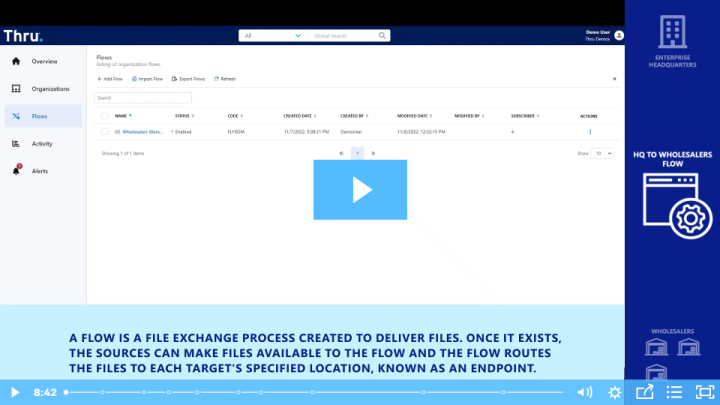Managed File Transfer as a Service (MFTaaS)
Product Overview
Thru’s cloud-native managed file transfer solution secures transfers between users, customers, partners and businesses:
- End-to-end protection ensures sensitive, critical data stays protected.
- Tracking, monitoring and retention rules allow auditability to help meet compliance regulations and governance.
- APIs and pre-built connectors provide seamless integration of file transfers to integration platforms (iPaaS), applications or endpoints.
- Distributed hybrid architecture enables internal file transfers on a network with control plane in the cloud.
How Thru’s Managed File Transfer Works for Your Business
Enjoy benefits of file transfers in the cloud
Hand off deployment, maintenance, scaling and more to Thru’s award-winning team of managed file transfer experts.
Cloud MFT »
Work efficiently by automating file transfers
Condense hundreds of time-consuming point-to-point connections into a few reusable Thru workflows. Onboard partners in mere minutes.
MFT Automation »
Connect file transfers with other systems
Add guaranteed delivery and persistence to file transfers in your integration platform. Use our API to automatically configure Thru entities or streamline monitoring.
Integrate MFT »
Protect data with state-of-the-art security
Security measures are built into every layer of Thru, including antivirus scanning, end-to-end encryption (E2EE) and a full audit trail to help meet governance and compliance regulations.
Secure File Transfer »
Creating Solutions for Managed File Transfer Use Cases
Thru has been solving managed file transfer challenges for more than 20 years. Most file transfer needs are solved by one of these solutions:
Automate File Transfers
External Partner File Exchange »
Easily create and manage business-critical file transfers with external partners.
Internal File Transfers on a Network »
Deploy Thru Nodes for secure file transfer on the internal network with control plane in the cloud.
Remote Locations to Headquarters »
Modernize file transfers between headquarters and remote locations to meet security requirements.
Integrate MFT with Existing Software
API & Connectors »
Use APIs to create seamless interaction between middleware processing flows and Thru’s MFT flows.
Cloud MFT for iPaaS »
Transfer files using Thru’s connectors that natively integrate with Boomi or MuleSoft or use our APIs.
Secure File Transfer for Boomi »
Add guaranteed delivery and persistence to file transfers in Boomi with Thru’s MFT connector.
MFT Connector for MuleSoft® »
Directly integrate MuleSoft data processing flows with Thru file flows – no coding required.
MFT + Salesforce for ESD »
Securely deliver and track software to internal users and customers using Thru’s Salesforce connector.
Other MFT Initiatives
Move SFTP to Cloud »
Replace legacy SFTP servers with Thru’s cloud-based MFT service to modernize file transfer.
Replace On-Premises MFT »
Easily auto-scale to modernize file transfer across your organization by switching to cloud-based Thru.
Use MFT for Secure File Sharing
Ad Hoc Secure File Sharing »
Easily email large files and achieve additional benefits not available with the other file sharing solutions.
Secure Document Exchange »
Experience confidentiality and accountability that sending files via other means does not achieve.
Remain Compliant Using MFT
Overview »
See several key features that help achieve compliance when transferring files.
GDPR »
Help protect EU citizens’ and residents’ personal data by using MFT to transfer files.
GxP »
MFT core features help achieve compliance to GxP and FDA 21 CFR Part 11.
HIPAA »
Help safeguard patients’ protected health information (PHI) when transferring files by using MFT.
PCI DSS »
MFT solutions have features that secure file transfers to help companies achieve compliance.
What Users Say about Thru’s MFT Solutions
G2 Reviews of our managed file transfer solutions »
4.6/5
“Easy to provision with just a click of a button. Great customer support.”
Administrator
in Warehousing
“Pure and straightforward SaaS solution.”
Rok S.
IT Manager
“Learning curve is very soft. No issues regarding both setup and service availability.”
Pedro D.
Business Unit Senior Manager
Middleware and API Management

